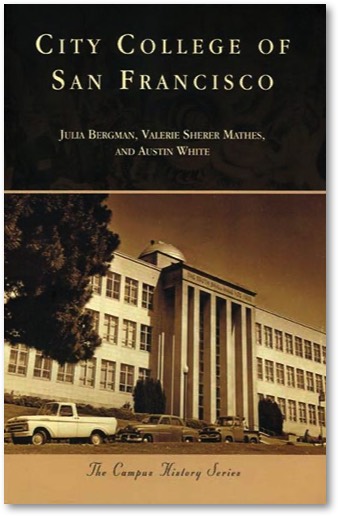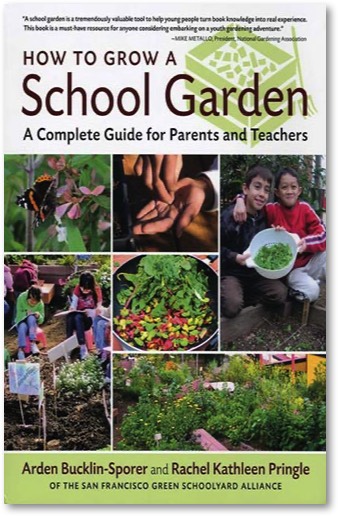
Musings » City College of San Francisco: A History and How To Grow A School Garden


Bergman, Julia, Valerie Sherer Mathes and Austin White
Charleston, South Carolina
Arcadia Publishing 2010
Charleston, South Carolina
Arcadia Publishing 2010

Bucklin-Sporer, Arden and Rachel Kathleen Pringle
Portland, Oregon
Timber Press 2010
The library receives gifts from time to time but it is unusual for it to receive two books on the same day. This is indeed a happy occasion. Both books are signed by their authors, though Austin White died before this book came out. Mrs White took his signature and made it into a stamp for this purpose.
City College of San Francisco is part of an Acadia Publishing series on campus history. Arcadia has developed a very successful formula both for its principal volumes, defining the history of communities or small towns across the United states and this campus series. It depends on archival images which otherwise might be lost and a minimum of text. For example there are several volumes about parts of San Francisco such as the Fillmore. In my opinion one can never know too much about those who preceded us and how they lived.
The City College of San Francisco is what can be called a “hinge institution”. It was started in 1935 as the Depression was ravaging the country. Once a student gets started at the college he or she has a good shot at advancing their life and career in a very tangible way, the “hinge” effect. Listening to some of their stories teaches one a great deal of humility. Some students hold down more than one job while attending the college and overcome tremendous obstacles.
The club has long recognized the importance of this college and supported it unfailingly for more than 50 years. The department of environmental horticulture and floristry began very early, in 1938. (See pages 74 and 75.)
Arden Bucklin-Sporer and Rachel Kathleen Pringle (How to Grow a School Garden) also fit right in with the club’s philosophy. The club sees part of its mission to help educate children about gardens who otherwise may never have that marvellous experience. Creating gardens at city schools very definitely beautifies the city.
The fact that children learn to grow vegetables is an additional bonus. So many of them have very narrow and less than healthy diets for many reasons and getting them to try fresh produce is hard. If they grow it themselves, following the process of germination, full flowering and ripening, they are much more likely to eat the food with pride and persuade their families to eat it too.
The authors cover all aspects of the programs, from the slightly dry but indispensible budget process to the actual organizing of a class of eager children digging and watering with gusto. Involving the teacher is crucial. A well organized class can learn not only biology but math almost painlessly. Designing the best layout for each individual piece of property is also essential.
Some schools have taken the initiative on their own, such as the KIPP Academy in Bayview. The club has supported this school’s gardening program for 2 years in a row. One valuable aspect of the grassroots approach in all these endeavors is how the families get involved. If the children are immigrants very often their fathers have been agricultural workers and can contribute a lot to the gardens at weekends.
Another very small but viable organization is Urban Sprouts, the brainchild of Abby Jaramillo. She started out with a single 6th grade class but now has some assistants and aides teaching children from several grades in different schools. Gardening has been folded into biology class with resulting benefits for all. She too has seen how helpful it is to involve the families. When enough produce is grown the gardeners invite the rest of the school to eat with them, a great source of pride.
City College of San Francisco is part of an Acadia Publishing series on campus history. Arcadia has developed a very successful formula both for its principal volumes, defining the history of communities or small towns across the United states and this campus series. It depends on archival images which otherwise might be lost and a minimum of text. For example there are several volumes about parts of San Francisco such as the Fillmore. In my opinion one can never know too much about those who preceded us and how they lived.
The City College of San Francisco is what can be called a “hinge institution”. It was started in 1935 as the Depression was ravaging the country. Once a student gets started at the college he or she has a good shot at advancing their life and career in a very tangible way, the “hinge” effect. Listening to some of their stories teaches one a great deal of humility. Some students hold down more than one job while attending the college and overcome tremendous obstacles.
The club has long recognized the importance of this college and supported it unfailingly for more than 50 years. The department of environmental horticulture and floristry began very early, in 1938. (See pages 74 and 75.)
Arden Bucklin-Sporer and Rachel Kathleen Pringle (How to Grow a School Garden) also fit right in with the club’s philosophy. The club sees part of its mission to help educate children about gardens who otherwise may never have that marvellous experience. Creating gardens at city schools very definitely beautifies the city.
The fact that children learn to grow vegetables is an additional bonus. So many of them have very narrow and less than healthy diets for many reasons and getting them to try fresh produce is hard. If they grow it themselves, following the process of germination, full flowering and ripening, they are much more likely to eat the food with pride and persuade their families to eat it too.
The authors cover all aspects of the programs, from the slightly dry but indispensible budget process to the actual organizing of a class of eager children digging and watering with gusto. Involving the teacher is crucial. A well organized class can learn not only biology but math almost painlessly. Designing the best layout for each individual piece of property is also essential.
Some schools have taken the initiative on their own, such as the KIPP Academy in Bayview. The club has supported this school’s gardening program for 2 years in a row. One valuable aspect of the grassroots approach in all these endeavors is how the families get involved. If the children are immigrants very often their fathers have been agricultural workers and can contribute a lot to the gardens at weekends.
Another very small but viable organization is Urban Sprouts, the brainchild of Abby Jaramillo. She started out with a single 6th grade class but now has some assistants and aides teaching children from several grades in different schools. Gardening has been folded into biology class with resulting benefits for all. She too has seen how helpful it is to involve the families. When enough produce is grown the gardeners invite the rest of the school to eat with them, a great source of pride.

